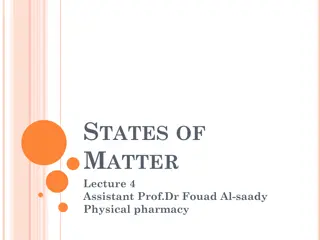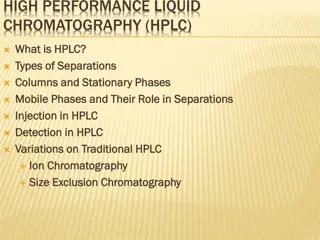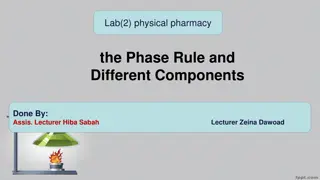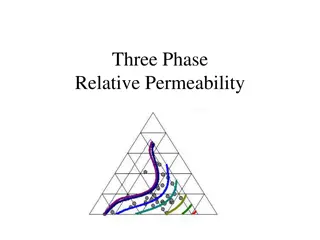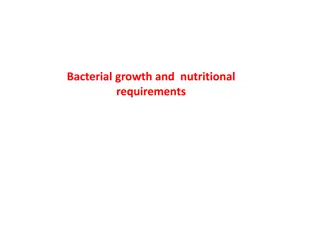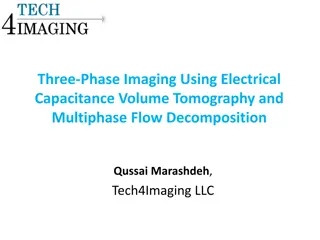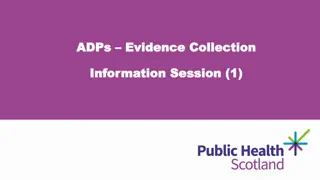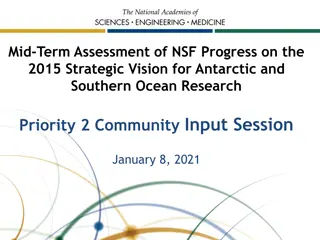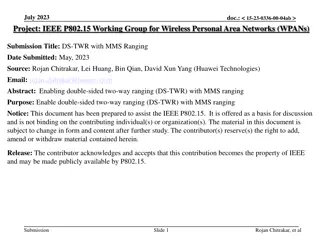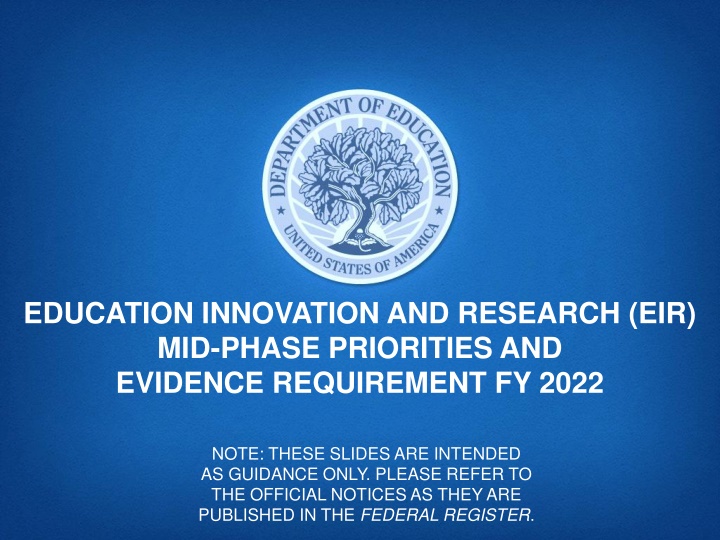
EIR Mid-Phase Priorities and Evidence Requirements FY 2022
Explore the mid-phase priorities and evidence requirements for the Education Innovation and Research program in FY 2022. Applicants must focus on moderate evidence and select from absolute priorities like field-initiated innovations and equity promotion. Detailed guidelines provided for project support and evidence submission.
Download Presentation

Please find below an Image/Link to download the presentation.
The content on the website is provided AS IS for your information and personal use only. It may not be sold, licensed, or shared on other websites without obtaining consent from the author. If you encounter any issues during the download, it is possible that the publisher has removed the file from their server.
You are allowed to download the files provided on this website for personal or commercial use, subject to the condition that they are used lawfully. All files are the property of their respective owners.
The content on the website is provided AS IS for your information and personal use only. It may not be sold, licensed, or shared on other websites without obtaining consent from the author.
E N D
Presentation Transcript
EDUCATION INNOVATION AND RESEARCH (EIR) MID-PHASE PRIORITIES AND EVIDENCE REQUIREMENT FY 2022 NOTE: THESE SLIDES ARE INTENDED AS GUIDANCE ONLY. PLEASE REFER TO THE OFFICIAL NOTICES AS THEY ARE PUBLISHED IN THE FEDERAL REGISTER.
MID-PHASE PRIORITIES All Mid-phase applicants must address this priority. Absolute Priority (AP) 1: Moderate Evidence Moderate Evidence means evidence from at least one well designed and well implemented quasi-experimental study. Applicants MUST identify up to two studies to be reviewed against the What Works Clearinghouse (WWC) Handbooks (as defined in this notice) for the purposes of meeting the definition of moderate evidence. 2
ABSOLUTE PRIORITIES (CONT.) Mid-phase applicants must select one of the absolute priorities listed below. Applicants must clearly indicate which one in their abstract and project narrative Absolute Priority 2: Field-Initiated Innovations General Absolute Priority 3: Field-Initiated Innovations Promoting Equity in Student Access to Educational Resources and Opportunities: STEM Absolute Priority 4: Field-Initiated Innovations Meeting Student Social, Emotional, and Academic Needs 3
MID-PHASE ABSOLUTE PRIORITY 1 Projects supported by evidence that meets the conditions in the definition of moderate evidence. Note: An applicant must identify up to two studies to be reviewed against the What Works Clearinghouse (WWC) Handbooks (as defined in this notice) for the purposes of meeting the definition of moderate evidence. The studies may have been conducted by the applicant or by a third party. An applicant must clearly identify the citations for each study in the Evidence form. An applicant must ensure that all cited studies are available to the Department from publicly available sources and provide links or other guidance indicating where each is available. The Department may not review a study that an applicant fails to clearly identify for review. 4
MID-PHASE ABSOLUTE PRIORITY 1--CONT In addition to including up to two study citations, an applicant must provide in the Evidence form the following information: (1) the positive student outcomes the applicant intends to replicate under its Mid-phase grant and how these outcomes correspond to the positive student outcomes in the cited studies; (2) the characteristics of the population or setting to be served under its Mid-phase grant and how these characteristics correspond to the characteristics of the population or setting in the cited studies; and (3) the practice(s) the applicant plans to implement under its Mid-phase grant and how the practice(s) correspond with the practice(s) in the cited studies. If the Department determines that an applicant has provided insufficient information, the applicant will not have an opportunity to provide additional information. However, if the WWC determines that a study does not provide enough information on key aspects of the study design, such as sample attrition or equivalence of intervention and comparison groups, the WWC may submit a query to the study author(s) to gather information for use in determining a study rating. Authors would be asked to respond to queries within 10 business days. Should the author query remain incomplete within 14 days of the initial contact to the study author(s), the study may be deemed ineligible under the grant competition. After the grant competition closes, the WWC will, for purposes of its own curation of studies, continue to include responses to author queries and make updates to study reviews as necessary. However, no additional information will be considered after the competition closes and the initial timeline established for response to an author query passes. 5
MID-PHASE ABSOLUTE PRIORITY 2 Field-initiated innovations General Projects that are designed to create, develop, implement, replicate, or take to scale entrepreneurial, evidence-based, field-initiated innovations to improve student achievement and attainment for high-need students. 6
MID-PHASE ABSOLUTE PRIORITY 3 Field-initiated innovations -- Promoting Equity in Student Access to Educational Resources and Opportunities: STEM Projects that are designed to-- (a) Create, develop, implement, replicate, or take to scale entrepreneurial, evidence-based, field-initiated innovations to improve student achievement and attainment for high-need students; and (b) Promote educational equity and adequacy in resources and opportunity for underserved students (1) In one or more of the following educational settings: (i) Early learning programs. (ii) Elementary school. (iii) Middle school. (iv) High school. (v) Career and technical education programs. (vi) Out-of-school-time settings. (vii) Alternative schools and programs. (viii) Juvenile justice system or correctional facilities; 7
MID-PHASE ABSOLUTE PRIORITY 3 Field-initiated innovations -- Promoting Equity in Student Access to Educational Resources and Opportunities: STEM Con t. (2) That examine the sources of inequity and inadequacy and implement responses, including rigorous, engaging, and well-rounded (e.g., that include music and the arts) approaches to learning that are inclusive with regard to race, ethnicity, culture, language, and disability status and prepare students for college, career, and civic life, including science, technology, engineering, and mathematics (STEM), including computer science coursework. 8
MID-PHASE ABSOLUTE PRIORITY 4 Field-initiated innovations -- Meeting Student Social, Emotional, and Academic Needs Projects that are designed to-- a) Create, develop, implement, replicate, or take to scale entrepreneurial, evidence-based, field-initiated innovations to improve student achievement and attainment for high-need students; and b) Improve students social, emotional, academic, and career development, with a focus on underserved students through one or more of the following priority areas: 9
MID-PHASE ABSOLUTE PRIORITY 4 Field-initiated innovations -- Meeting Student Social, Emotional, and Academic Needs Cont. (1) Developing and supporting educator and school capacity to support social and emotional learning and development that-- (i) Fosters skills and behaviors that enable academic progress; (ii) Identifies and addresses conditions in the learning environment, that may negatively impact social and emotional well-being for underserved students, including conditions that affect physical safety; and (iii) Is trauma-informed, such as addressing exposure to community-based violence and trauma specific to military- or veteran-connected students (as defined in this notice). 10
MID-PHASE ABSOLUTE PRIORITY 4 Field-initiated innovations -- Meeting Student Social, Emotional, and Academic Needs Cont. (2) Creating education or work-based settings that are supportive, positive, identity-safe and inclusive with regard to race, ethnicity, culture, language, and disability status, through one or more of the following activities: (i) Developing trusting relationships between students (including underserved students), educators, families, and community partners. (ii) Providing high-quality professional development opportunities designed to increase engagement and belonging and build asset- based mindsets for educators working in and throughout schools. (iii) Engaging students (including underserved students), educators, families, and community partners from diverse backgrounds and representative of the community as partners in school climate review and improvement efforts. 11
MID-PHASE ABSOLUTE PRIORITY 4 Field-initiated innovations -- Meeting Student Social, Emotional, and Academic Needs Cont. (iv) Developing and implementing inclusive and culturally informed discipline policies and addressing disparities in school discipline policy by identifying and addressing the root causes of those disparities, including by involving educators, students, and families in decision-making about discipline procedures and providing training and resources to educators. (v) Supporting students to engage in real-world, hands-on learning that is aligned with classroom instruction and takes place in community-based settings, such as apprenticeships, pre- apprenticeships, work-based learning, and service learning, and in civic activities, that allow students to apply their knowledge and skills, strengthen their employability skills, and access career exploration opportunities. 12
MID-PHASE ABSOLUTE PRIORITY 4 Field-initiated innovations -- Meeting Student Social, Emotional, and Academic Needs Cont. (3) Providing multi-tiered systems of supports that address learning barriers both in and out of the classroom, that enable healthy development and respond to students needs and which may include evidence-based trauma-informed practices and professional development for educators on avoiding deficit-based approaches. (4) Developing or implementing policies and practices, consistent with applicable Federal law, that prevent or reduce significant disproportionality on the basis of race or ethnicity with respect to the identification, placement, and disciplining of children or students with disabilities (as defined in this notice). (5) Providing students equitable access that is inclusive, with regard to race, LGBTQI+, ethnicity, culture, language, and disability status, to social workers, psychologists, counselors, nurses, or mental health professionals and other integrated services and supports, which may include in early learning environments. 13
MID-PHASE ABSOLUTE PRIORITY 4 Field-initiated innovations -- Meeting Student Social, Emotional, and Academic Needs Cont. (6) Preparing educators to implement project-based or experiential learning opportunities for students to strengthen their metacognitive skills, self-direction, self-efficacy, competency, or motivation, including through instruction that: Connects to students prior knowledge and experience; provides rich, engaging, complex, and motivating tasks; and offers opportunities for collaborative learning. (7) Creating and implementing comprehensive schoolwide frameworks (such as small schools or learning communities, advisory systems, or looping educators) that support strong and consistent student and educator relationships. (8) Fostering partnerships, including across government agencies (e.g., housing, human services, employment agencies), local educational agencies, community-based organizations, adult learning providers, and postsecondary education intuitions, to provide comprehensive services to students and families that support students social, emotional, mental health, and academic needs, and that are inclusive with regard to race, ethnicity, culture, language, and disability status. 14
COMPETITIVE PREFERENCE PRIORITIES Applicants have the option of addressing one or more of the Competitive Preference Priorities, regardless of which absolute priority they select Competitive Preference Priority 1: Competitive Preference Priority 2: Promoting Equity in Student Access to Educational Resources and Opportunities Addressing the Impact of COVID 19 on Students, Educators, and Faculty 15
COMPETITIVE PREFERENCE PRIORITY 1-- Promoting Equity in Student Access to Educational Resources and Opportunities Projects designed to promote educational equity and adequacy in resources and opportunity for underserved students in middle school or high school that examine the sources of inequity and inadequacy and implement responses, including rigorous, engaging, and well-rounded (e.g., that include music and the arts) approaches to learning that are inclusive with regard to race, ethnicity, culture, language, and disability status and prepare students for college, career, and civic life, including one or more of the following: (a) Student-centered learning models that may leverage technology to address learner variability (e.g., universal design for learning (as defined in this notice), K 12 competency-based education (as defined in this notice), project-based learning, or hybrid/blended learning) and provide high-quality learning content, applications, or tools. (b) Middle school courses or projects that prepare students to participate in advanced coursework in high school. (c) Advanced courses and programs, including dual enrollment and early college programs. (d) Project-based and experiential learning, including service and work-based learning. (e) High-quality career and technical education courses, pathways, and industry- recognized credentials that are integrated into the curriculum. 16
COMPETITIVE PREFERENCE PRIORITY 2-- Addressing the Impact of COVID 19 on Students, Educators, and Faculty Projects that are designed to address the impacts of the COVID 19 pandemic, including impacts that extend beyond the duration of the pandemic itself, on the students most impacted by the pandemic, with a focus on underserved students and the educators who serve them through-- (a) Conducting community asset-mapping and needs assessments that may include an assessment of the extent to which students, including subgroups of students, have become disengaged from learning, including students not participating in in-person or remote instruction, and specific strategies for reengaging and supporting students and their families; and (b) Using evidence-based instructional approaches and supports, such as professional development, coaching, ongoing support for educators, high quality tutoring, expanded access to rigorous coursework and content across K 12, and expanded learning time to accelerate learning for students in ways that ensure all students have the opportunity to successfully meet challenging academic content standards without contributing to tracking or remedial courses. 17
WHAT IS MODERATE EVIDENCE? (1 OF 2) Moderate evidence means that there is evidence of effectiveness of a key project component in improving a relevant outcome (as defined in this notice) for a sample that overlaps with the populations or settings proposed to receive that component, based on a relevant finding from one of the following: (i) A practice guide prepared by the WWC using version 2.1, 3.0, 4.0, or 4.1 of the WWC Handbooks reporting a strong evidence base or moderate evidence base for the corresponding practice guide recommendation; (ii) An intervention report prepared by the WWC using version 2.1, 3.0, 4.0, or 4.1 of the WWC Handbooks reporting a positive effect or potentially positive effect on a relevant outcome based on a medium to large extent of evidence, with no reporting of a negative effect or potentially negative effect on a relevant outcome; or (continued) 18
WHAT IS MODERATE EVIDENCE? (2 OF 2) (iii) A single experimental study (as defined in this notice) or quasi- experimental design study (as defined in this notice) reviewed and reported by the WWC using version 2.1, 3.0, 4.0, or 4.1 of the WWC Handbooks, or otherwise assessed by the Department using version 4.1 of the WWC Handbook, as appropriate and that (A) Meets WWC standards with or without reservations; (B) Includes at least one statistically significant and positive (i.e., favorable) effect on a relevant outcome; (C) Includes no overriding statistically significant and negative effects on relevant outcomes reported in the study or in a corresponding WWC intervention report prepared under version 2.1, 3.0, 4.0, or 4.1of the WWC Handbooks; and (D) Is based on a sample from more than one site (e.g., States, counties, cities, school districts, or postsecondary campuses) and includes at least 350 students or other individuals across sites. Multiple studies of the same project component that each meet requirements in paragraphs (iii)(A), (B), and (C) of this definition may together satisfy this requirement. 19
HOW DO YOU DEMONSTRATE THAT YOU MEET MODERATE EVIDENCE? Use the Evidence form that is included in the application package Identify up to 2 study citations to be reviewed against the WWC handbook, and for each include a description of: The positive student outcomes to be replicated, and a description of how the characteristics of the students in the study correspond to those high needs students proposed in the application how the proposed practices correspond between the study and the proposed application the intended student outcomes that the proposed practice(s) attempts to impact Citations must refer to publicly available sources (provide links or other guidance) Applicants will NOT get an opportunity to provide additional information; however, study authors may be asked by the WWC to respond to queries on key aspects of the study design. 20
MID-PHASE EVIDENCE STANDARDS CHECKLIST Absolute Priority 1 - Moderate Evidence Standards Checklist This Evidence Requirements Checklist is intended to help applicants determine what studies to include on the Evidence Form with their application for the purposes of meeting the evidence requirement. This checklist is a resource and not required in the grant application. As such, the checklist should not be submitted with the application. Applicants can use the checklist as an informal worksheet to understand the evidence criteria used to review studies and learn about additional evidence-related resources available online. 22
CONSIDERATIONS FOR SELECTING EVIDENCE Is it a quasi-experimental or experimental study? Is there a finding that is relevant to a proposed practice of your project? Does the cited finding examine the relationship between a practice and a student outcome or other relevant outcome? Is the cited finding based on a large sample? Is the cited finding based on a multi-site sample? Does the sample for the cited finding overlap with a population or setting for your proposed project? Is the cited finding a statistically significant and positive effect? 23
WHAT WORKS CLEARINGHOUSE In reviewing potential sources of moderate evidence, you might first review the What Works Clearinghouse to determine if there is an intervention report, practice guide, or individual study that has already been reviewed. Institute of Education Sciences Finding Evidence on What Works Clearinghouse Webinar is a helpful resource. Tier 1 or Tier 2 studies have the potential to meet the moderate evidence definition. Tier 3 and Tier 4 studies will NOT meet the moderate evidence definition. The Department will use Study Review Protocol Version 4.1 to conduct new evidence reviews. 24
RURAL LOCAL EDUCATION AGENCY (LEA) DEFINITION Traditionally underrepresented students served under this priority can include students in communities served by Rural LEAs. The Mid-phase NIA defines Rural LEA as the following: Rural local educational agency means a local educational agency that is eligible under the Small Rural School Achievement (SRSA) program or the Rural and Low-Income School (RLIS) program authorized under Title V, Part B of the ESEA. Eligible applicants may determine whether a particular district is eligible for these programs by referring to information on the Department's website at https://oese.ed.gov/files/2021/05/FY2021_Master_Eligibility_S preadsheet-public51221.xlsx *please use the updated the link. 25
REMINDER: MID-PHASE GRANTEES ARE ENCOURAGED TO SCALE TO A REGIONAL OR NATIONAL LEVEL Regional (see definition in the notice inviting applications): Serve a variety of communities in a state or multiple states Serve different student groups If an LEA-based project, must serve students in more than one LEA National (see definition in the notice inviting applications): Serve a wide variety of communities Serve different student groups Resource for consideration: Scaling up Evidence-Based Practices: Strategies from Investing in Innovation (i3) 26
THANK YOU! EIR EMAIL: EIR@ED.GOV EIR PHONE: (202) 453-7122






